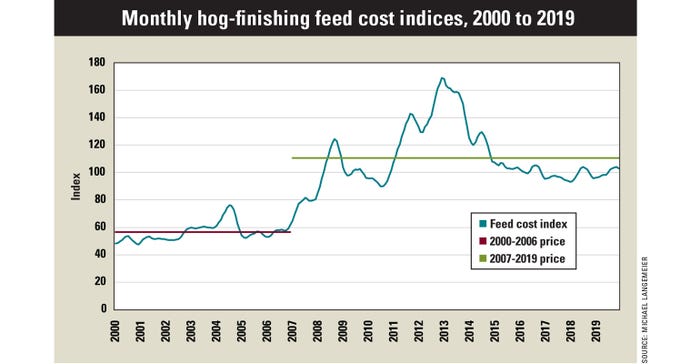January 30, 2020

Corn prices were volatile in 2019. Given the uncertainty regarding what gets planted on 2019 prevented planting acres, corn prices are likely to be volatile in 2020 as well. This article examines the impact of different corn price projections on feed costs for a swine finishing enterprise.
The swine enterprise assumes finishing early-weaned pigs. The ration consists of corn, soybean meal, dried distillers grains and supplements.
Corn prices represent averages for Indiana as reported by the USDA National Agricultural Statistics Service. Soybean meal and distillers grains prices are obtained from “Feed Outlook,” published monthly by the USDA Economic Research Service. Information from “Agricultural Prices,” a monthly NASS publication, was used to compute supplement prices. Future prices for corn and soybean meal are used to project feed indices through 2019. Feed cost indices are reported on a closeout-month basis rather than a placement-month basis.
Corn, soymeal prices
Since January 2007, the average corn price is $4.53 per bushel and the average soymeal price is $351 per ton. Except for July 2019, the corn price hasn’t been above the average experienced during the 2007-to-2019 period since the first half of 2014.
Soymeal prices were above the average from February through June 2018.
At the present time, corn prices have more upside potential than soymeal prices.

Indices were used to examine variability in swine finishing feed costs. We examined monthly swine finishing feed cost indices for January 2000 to December 2019. The latest full year of indices, 2019, has an index of 100, so all indices for other years are expressed in relative terms compared to 2019. The average index for 2000 to 2006, before the ethanol boom, is 56, while the average index for the period beginning in 2007 is 111.
Projections for 2020 used corn and soybean price estimates in early January. The projected feed cost index for 2020 is 101. This indicates that with current price projections, feed costs in 2020 will be similar to 2019. However, given the uncertainty regarding corn acreage, corn prices could potentially be higher than current projections.
Sensitivity analysis
Feed costs are very sensitive to changes in corn and soybean meal prices. Regression analysis examined the relationship between hog finishing costs and corn and soymeal prices. Each 10-cent increase in corn prices increases feed cost per hundredweight by 44 cents, and each $10 increase in soymeal prices increases feed cost per hundredweight by 32 cents.
Feed cost in December was $32.72 per cwt. Using expected corn and soymeal prices, feed cost is expected to range from $31 to $33 per cwt in 2020.
Let’s examine low and high price scenarios. A corn price of $3.50 per bushel and a soymeal price of $275 per ton would result in a feed cost of $28.25 per cwt. In contrast, corn at $4.50 and soymeal at $375 would put feed cost at $34.85 per cwt.
Given the uncertainty pertaining to corn and soybean meal prices, it would be prudent to incorporate a relatively wide set of prices in swine finishing feed cost budgets.
Langemeier is a Purdue University Extension agricultural economist and associate director of the Purdue Center for Commercial Agriculture. He writes from West Lafayette, Ind.
About the Author(s)
You May Also Like






